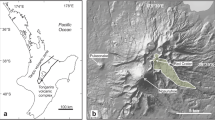Abstract
We have measured the δ18O values of the major phenocrysts (olivine, clinopyroxene and plagioclase) present in lavas from Tristan da Cunha and Gough Island. These islands, which result from the same mantle plume, have enriched radiogenic isotope ratios and are, therefore, prime candidates for an oxygen isotope signature that is distinct from that of MORB. Consistent differences between the δ18O values of olivine, pyroxene and feldspar in the Gough lavas show that the phenocrysts in the mafic Gough Island lavas are in oxygen isotope equilibrium. The olivines in lavas with SiO2 <50 wt% have a mean δ18O value of 5.19‰, consistent with crystallization from a magma having the same oxygen isotope composition as MORB. Phenocrysts in all the Gough lavas show a systematic increase in δ18O value as silica content increases, which is consistent with closed-system fractional crystallization. The lack of enrichment in δ18O of the Gough magmas suggests that the mantle source contained <2% recycled sediment. In contrast, the Tristan lavas with SiO2 >48 wt% contain phenocrysts which have δ18O values that are systematically ∼0.3‰ lower than their counterparts from Gough. We suggest that the parental mafic Tristan magmas were contaminated by material from the volcanic edifice that acquired low δ18O values by interaction with water at high temperatures. The highly porphyritic SiO2-poor lavas show a negative correlation between olivine δ18O value and whole-rock silica content rather than the expected positive correlation. The minimum δ18O value occurs at an SiO2 content of about 45 wt%. Below 45 wt% SiO2, magmas evolved via a combination of assimilation, fractionational crystallization and crystal accumulation; above 45 wt% SiO2, magmas appeared to have evolved via closed-system fractional crystallization.
Similar content being viewed by others
Author information
Authors and Affiliations
Additional information
Received: 23 November 1998 / Accepted: 27 September 1999
Rights and permissions
About this article
Cite this article
Harris, C., Smith, H. & le Roex, A. Oxygen isotope composition of phenocrysts from Tristan da Cunha and Gough Island lavas: variation with fractional crystallization and evidence for assimilation. Contrib Mineral Petrol 138, 164–175 (2000). https://doi.org/10.1007/s004100050015
Issue Date:
DOI: https://doi.org/10.1007/s004100050015




